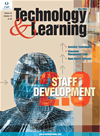Here are some random thoughts about technology that cause me to lay awake at night...
The Kids know so much about technology Thing: are you sure about that? In the conversations that I have with kids in my district about technology, it is apparent that there is a "Big Five." I'll bet you can guess: IM, video games, and cell phones, and mp3 players, and yes, the dreaded MySpace. They have that down. But I've seen many kids struggle with some simple operations with computers. Are kids, as a group, podcasting, blogging and using wiki technology? Maybe they are in your schools, but not in the ones I work in or visit. Now, do they have the affinity to learn new technologies rapidly-absolutely. They do possess that, but how much of that do we as educators exploit?
The Teacher as blogger Thing: Realistically, does anyone besides
Mark really think that teachers will contribute
on a large scale to the blogospheric conversation? An inflammatory statement I know, but c'mon, think about it. Look at all the pressures on teachers, planning lessons, grading papers, calling parents, serving on committees, etc. Time for blogging? I don't think so. At my recent TechForum presentation on professional development, I asked a pretty tech-savvy crowd how many actually were bloggers: 4 out of about 75. I do believe that many will read blogs and will post an occassional comment-maybe that is enough. And I do believe that the most important role that teachers will have in blogging is to get their kids to do it.
Are there some great teacher bloggers? You bet. But blogging in large numbers? I'll believe it when I see it.
The integrating technology Thing: why do we want teachers to integrate technology? Why do we use those terms? Do we integrate paper and pencils? Do we integrate textbooks? Maybe I'm being too sensitive to the phraseology, but the integration thing does have its implications-we want you to do more-we want you to integrate technology into your curriculum. I've heard teachers say this: "Now you want me to integrate technology-I don't have time for that." It also implies a top-down bolt-on methodology where technology is added to a current lesson or a curricular sequence, in some cases, where it might not be welcome, or even appropriate. Technology use should be bottom-up, and should be a choice during the lesson design process, where instructional methodologies are chosen. Should I use a lecture, should I structure the class into collaborative groups, what kind of assessment should I use that will give me the data I need to understand if they understand? Should I use some technology tool? Will the use of that tool add value to the lesson? It should be a choice when instruction is designed, not an afterthought to integrated later.
The kids as professional developer Thing: one of my personal favorites-let's get the kids to teach teachers about technology-now that's a good idea. Many teachers are intimidated by what kids know -having them teach about technology should reduce that angst, right? Simply stated, the teachers I work with deserve a professional educator knowledgeable about technology, classroom practice, assessment, the school's climate and culture, district or building goals, etc. to lead them in learning about teaching and technology . Nothing against the kids, but teachers are probably the hardest group to teach and this is too important. And I know we have an ample on-demand supply, but what other industry would consider something like this-honestly?
The use of the word training Thing: training is what you do to
dogs. It suggests a Pavlovian stimulus-response. For example, when you say:
Gibson's 12-ounce filet, medium-rare, I salivate. I don't want to train teachers-hey, given this, do that. I want them to know, to understand in the context of what they believe in, to reflect, to apply....
Use professional development, even staff development, but please consider eliminating the use of the word training.
The technology babysitting Thing: this drives me nuts. Technology Babysitting is when a teacher takes kids to a computer lab, they engage in some task, while the teacher sits at a table and grades papers, or worse yet, reads the paper. That's nice. Thanks for the effort. And what happens when you walk up to them and ask them about it? Take it from me, don't try it....
Enough for a Saturday morning....
















